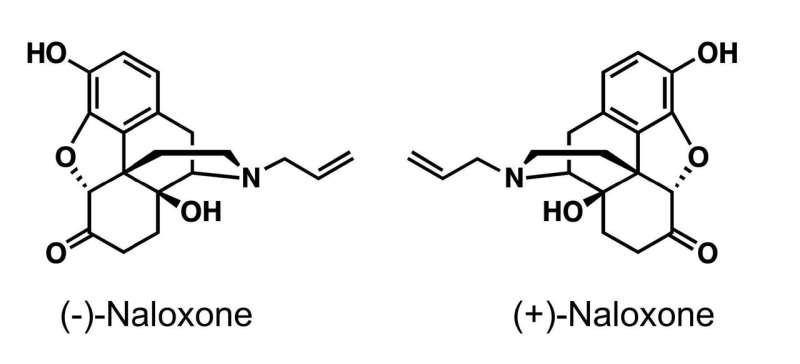Chemical structure of (-)-naloxone and (+)-naloxone enantiomers. Ki of (-)-naloxone for antagonizing opioid receptors is in the 1 nM range whereas (+)-naloxone has a very low affinity for opioid receptors with a Ki of 10 000 nM (Iijima et al., 1978). Credit: Anttila et al., eNeuro (2018)
The life-saving drug used to treat opioid overdose, naloxone, reduces brain inflammation in the aftermath of stroke in male rats. The preclinical research, published in eNeuro, lays the groundwork for developing the first drug to promote recovery from a leading cause of adult disability.
Naloxone has been used for decades to prevent death from drug overdose and has become widely used in recent years in response to the unrelenting opioid crisis. Although the therapeutic potential of naloxone in stroke has been explored, research in this area is limited to a few case studies from the 1980s and inconclusive clinical trials.
Brandon Harvey, Mikko Airavaara, and colleagues expand on this work by showing in a rat model of stroke that one week of treatment with naloxone, beginning one day after the stroke, tempered the brain's immune response in the first week and improved neurological function in the second week. A form of naloxone that has limited interaction with opioid receptors had similar effects as the one used in overdose treatment, which may circumvent the side effects of activating the opioid system. As with the naloxone nasal spray Narcan, the researchers administered the drug to rats though the nose at doses similar to those that have been shown to be safe in humans.
Together, these initial findings warrant further study of naloxone in different populations of animals and over a longer recovery period to investigate its potential for promoting recovery from stroke in humans.
More information: Post-stroke intranasal (+)-naloxone delivery reduces microglial activation and improves behavioral recovery from ischemic injury, eNeuro, DOI: 10.1523/ENEURO.0395-17.2018
Provided by Society for Neuroscience



















